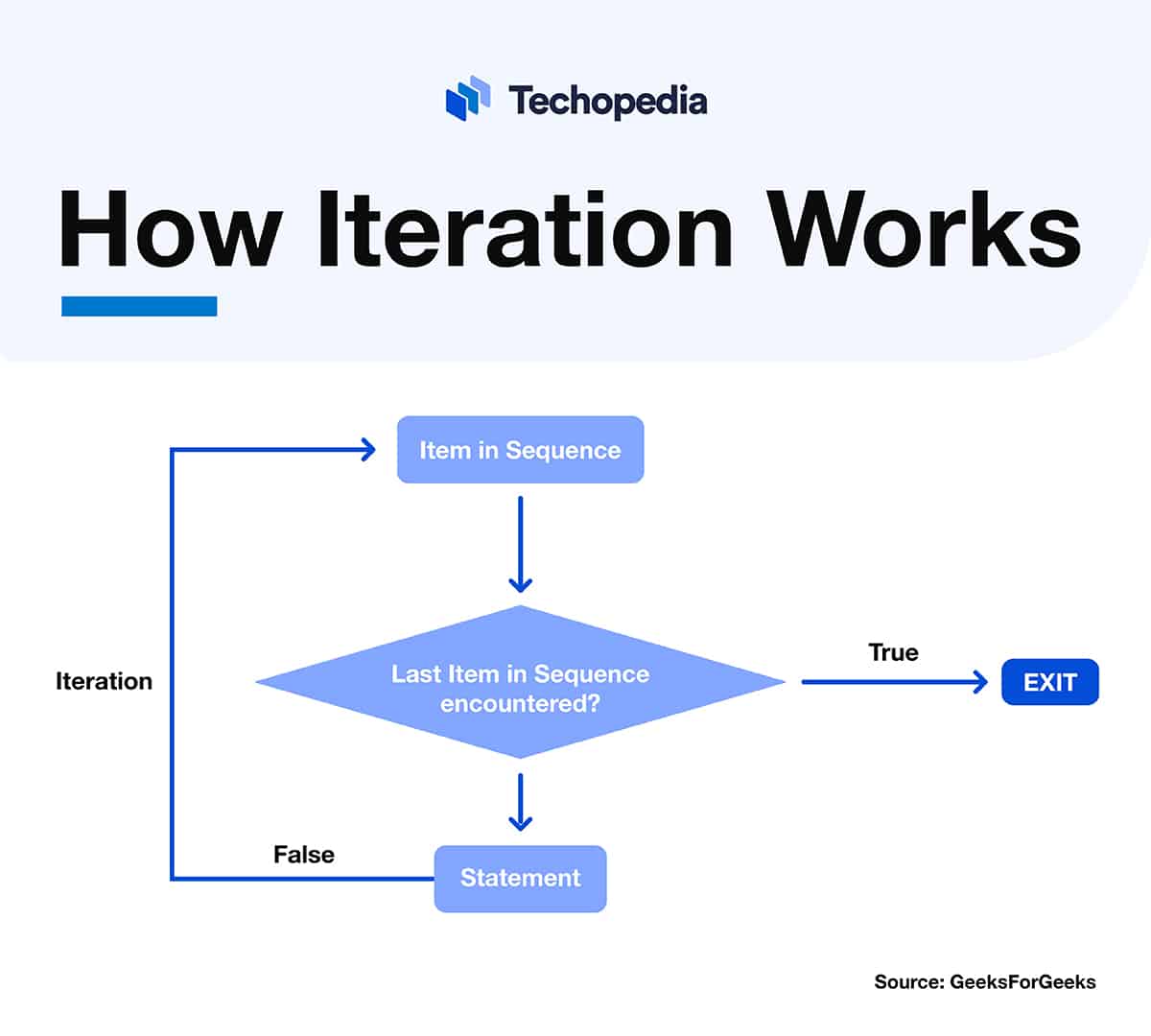What is Iteration?
Iteration in computer programming is the process of repeating a block of code (i.e., a set of instructions) in a sequence for a specified number of times, or until a certain condition is met. When a sequence of instructions is executed repeatedly, it forms a loop.
Iteration is a key component of programming logic. It’s used in various programming languages to automate repetitive tasks and create flexible algorithms.
The definition of iteration has additional meanings. In computing, it describes a new version of computer hardware or software (e.g., the latest iteration of an operating system (OS)).
Techopedia Explains the Iteration Meaning

Iteration is the repetition of a process in a computer program, usually done with the help of loops. In simple terms, iteration means doing something over and over again in a program. This repetition can happen a set number of times or until a certain condition is met.
This allows programmers to automate repetitive tasks. For example, if you wanted to print “Hello” five times to the console in a program, you would use iteration to repeat the printing process five times.
Origins and History of Iteration
The word itself comes from Latin and means ‘to repeat’ or ‘to do again.’ In everyday language, it refers to doing something over and over.
One of the earliest documented instances of iterative methods in mathematics is attributed to Carl Friedrich Gauss. In a letter dated December 26, 1823, Gauss described a method that can be considered iterative.
In computing, documented history of iteration dates back to the electronic numerical integrator and computer (ENIAC) in the 1940s when programmers used iteration to perform complex calculations.
How Iteration Works
Iteration works by repeating instructions a set number of times or until a condition is met and is controlled by loops.
It involves:
- Initialization
- Condition evaluation
- Iteration
- Update (increment/decrement)
This repeats until the condition is false, ending the loop.
Components of Iteration
The process of iteration typically includes the following components:
Iteration vs. Recursion Comparison Table
| Iteration | Recursion |
|---|---|
| Repeat a block of code a specified number of times or until a condition is met. | Function calls itself with updated data to solve problems in smaller pieces. |
| Uses loops (for/while) to control repeats. | Requires a base case that determines when it should stop. |
| Loops are simpler to execute, making iteration faster and more memory-efficient. | Can be slower and use more memory due to the overhead of function calls. |
| Better for most repeated tasks that don’t have a self-similar structure. | Better for self-similar problems where you can break things down into smaller versions. |
| Use cases: processing collections, searching and sorting algorithms, repetitive calculations. | Use cases: binary search, graph traversal, merge sort. |
Types of Iterations in Computer Programming
There are two main types of iterations:
Count-controlled loops (definite iteration)
Involves repeating a block of code when you know exactly how many times you want to repeat a task. This is achieved using ‘for’ loops, which iterate over a specified range of values.
Condition-controlled loops (indefinite iteration)
Involves repeating a block of code until a specific condition is met. This is achieved using ‘while’ loops, where the loop continues executing as long as the condition remains true.
Applications of Iteration
Example applications include the following:
- Cryptography
- Database operations
- Game development
- Image processing
- Machine learning (ML)
- Recursive algorithms
- Repetitive calculations
- Searching and Sorting
- Web scraping
Iteration Example
Below is an example of an iteration programming language.
Consider a database table containing 1000 student records. Each record contains the following fields:
- First name
- Last name
- Roll no
If one wants to copy all the student records from the database and print them, the best way to retrieve the record is to iterate or loop through each record. It can be executed using the for loop statement as shown below:
for (int i=0;i<1000;i++)
{
Print first name and last name from table
}
In the above example, ‘i’ is an iterator starting from the first student record to the last student record.
Iteration Benefits
Iteration offers several benefits in programming:
- Adaptability to changing conditions
- Efficiency in repetitive tasks
- Flexibility to adjust for varying scenarios
- Scalability to handle large datasets
- Simplifies complex problem-solving
- Testing and debugging incrementally
The Bottom Line
Iteration is a fundamental concept in programming, enabling the repetition of code blocks, allowing programmers to automate repetitive tasks, and creating flexible algorithms. Iteration is faster and more memory-efficient than alternatives like recursion and is useful for tasks such as calculations, searching, sorting, and processing data.
FAQs
What is Iteration in simple terms?
What is an example of iteration?
What are iterations in programming?
What are the 2 types of iteration?
References
- Iteration (Merriam-Webster)
- Iterative methods for linear systems of equations: A brief historical journey (University of Minnesota)
- 2: Engineering the ‘Miracle of the ENIAC’: Implementing the Modern Code Paradigm (ENIAC In Action)







